Cotton, one of the most important natural fibers in the textile industry, undergoes a fascinating life cycle that spans a series of crucial phenological stages. From its seed to the harvest of the fiber, cotton goes through a meticulous and rigorous process that determines its quality, yield, and value.
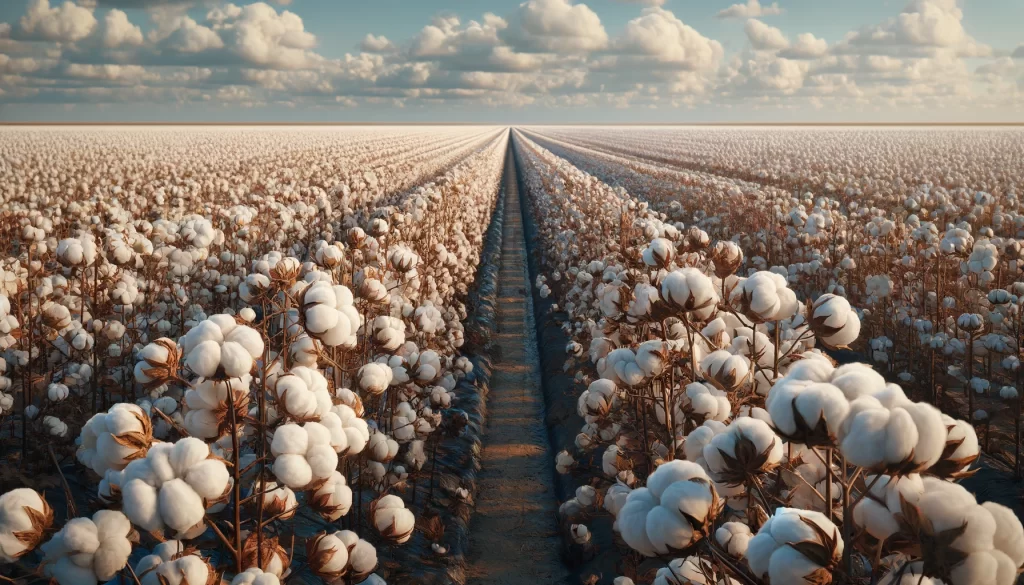
In this description, we will explore the various phenological stages of cotton cultivation, from seed germination to capsule maturation, highlighting key events and biological processes that characterize each phase. This detailed understanding of the cotton lifecycle is essential for farmers and the textile industry, as it influences cultivation practices, product quality, and the profitability of the crop.

Phenological Stages of Cotton
The phenological stages of cotton can vary slightly depending on the variety and specific cultivation conditions, but generally include the following:
Germination:
This is the beginning of the cotton life cycle, when the seed absorbs water and begins to germinate, leading to the emergence of the embryo and the development of the seedling.
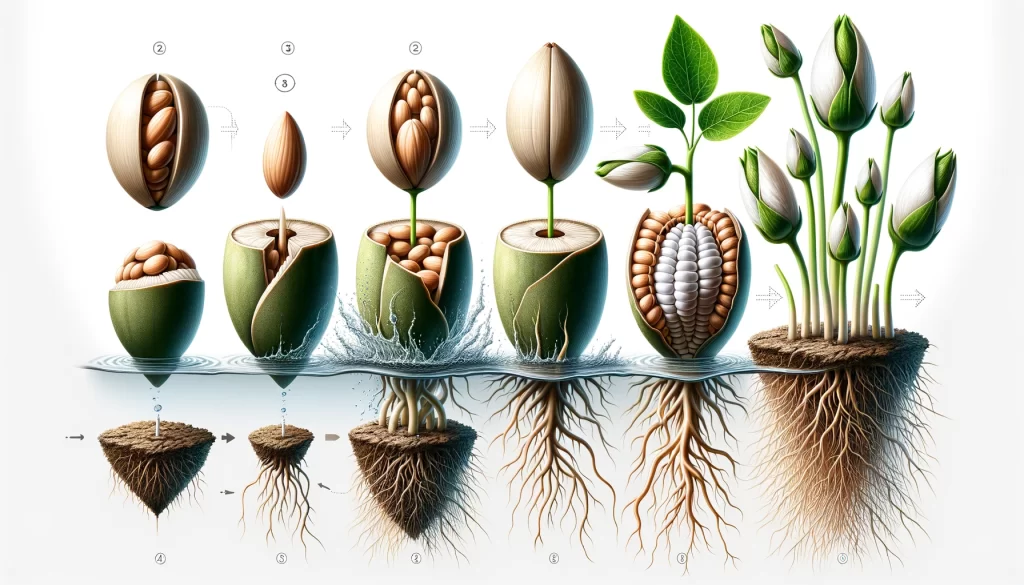
Cotton germination marks the beginning of the life cycle of this important textile plant. Here is a detailed description of this process:
- Seed preparation: Before planting, cotton seeds undergo various treatments to improve their germination. These treatments can include removing the fiber that surrounds the seed (delinting), treating with fungicides to prevent diseases, and conditioning to improve water absorption.
- Water absorption: The germination process begins when the cotton seed absorbs water from the surrounding soil. This process, known as imbibition, activates enzymes and metabolic processes within the seed, preparing it for germination.
- Metabolic activation: Once the seed has absorbed enough water, internal metabolic processes are activated. Nutrient reserves stored in the seed, such as starch and proteins, are converted into simpler forms that provide energy for the initial growth of the seedling.
- Emission of the radicle: The first visible structure to emerge from the seed during germination is the radicle, which will eventually become the primary root of the seedling. The radicle begins to grow downward in search of water and nutrients in the soil.
- Emergence of the hypocotyl and cotyledons: After the radicle, the hypocotyl emerges, which is the part of the seedling that connects the root to the stem. The cotyledons, which are the first embryonic leaves, also emerge and provide energy to the seedling during its early stages of growth.
- Development of the root system and stem: As the cotton seedling continues to grow, it develops a more extensive root system to absorb water and nutrients from the soil. Simultaneously, the stem begins to elongate upward, bringing the cotyledons to the soil surface.
- Establishment of the seedling: Once the seedling has fully emerged from the soil and developed a stable root system and stem, it is ready to begin active vegetative growth, producing additional leaves and preparing for the flowering phase.
Vegetative Development
During this stage, the cotton plant develops its root system and produces leaves and stems. Vigorous vegetative growth occurs to prepare the plant for flowering.
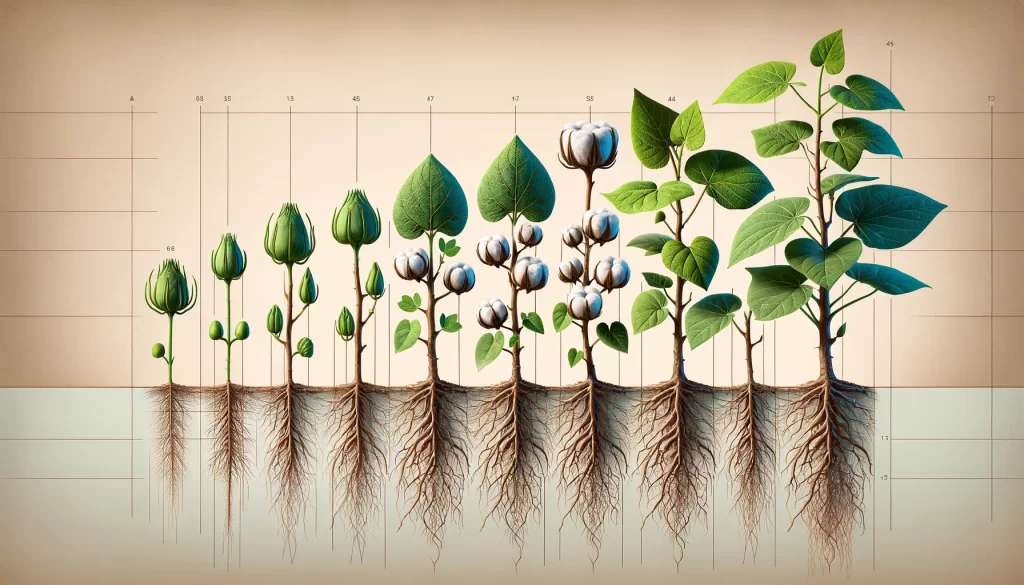
Vegetative development of cotton is a crucial stage in the life cycle of the plant, during which it experiences rapid growth and development of its vegetative structure. Here is a detailed description of this phase:
- Emergence of seedlings: After germination, cotton seedlings emerge from the soil and begin to develop their vegetative structure. At this stage, the seedlings rely on nutrient reserves stored in the seeds for their initial growth.
- Formation of leaves: Cotton seedlings begin to produce true leaves as they grow. These leaves are larger and have a more characteristic shape than the initial cotyledons. Leaves are crucial for photosynthesis, energy production, and the growth of the plant.
- Development of the root system: During vegetative development, the root system of the cotton plant continues to expand and branch out in the soil. A healthy root system is essential for absorbing water and nutrients from the soil, as well as providing stability to the plant.
- Elongation of the stem: The stem of the cotton plant undergoes rapid growth during vegetative development. This elongation of the stem allows the plant to reach an appropriate height to receive the necessary sunlight for photosynthesis and the proper development of the floral structure.
- Production of lateral branches: As the cotton plant continues to grow, it begins to produce lateral branches along the main stem. These lateral branches contribute to the development of a more complete and dense vegetative structure, which can influence the final yield of the plant.
- Biomass accumulation: During vegetative development, the cotton plant accumulates biomass as it produces new leaves, stems, and branches. This accumulation of biomass is crucial for growth and the formation of reproductive structures, such as flowers and fruits.
- Preparation for flowering: As the cotton plant reaches the final stage of vegetative development, it begins to prepare for the flowering phase. This can include the production of floral buds and the development of reproductive structures on the lateral branches of the plant.
Vegetative development of cotton is a dynamic and active stage in the life cycle of the plant, setting the foundation for success in later stages of cultivation, such as flowering and the formation of cotton capsules. Proper management during this phase is critical to ensure vigorous and healthy growth of plants, which can influence the yield and quality of the harvest.
Flowering
This stage is crucial in the life cycle of cotton, when the plant begins to produce flowers. Cotton flowers are white or yellow and form in the axils of the leaves.
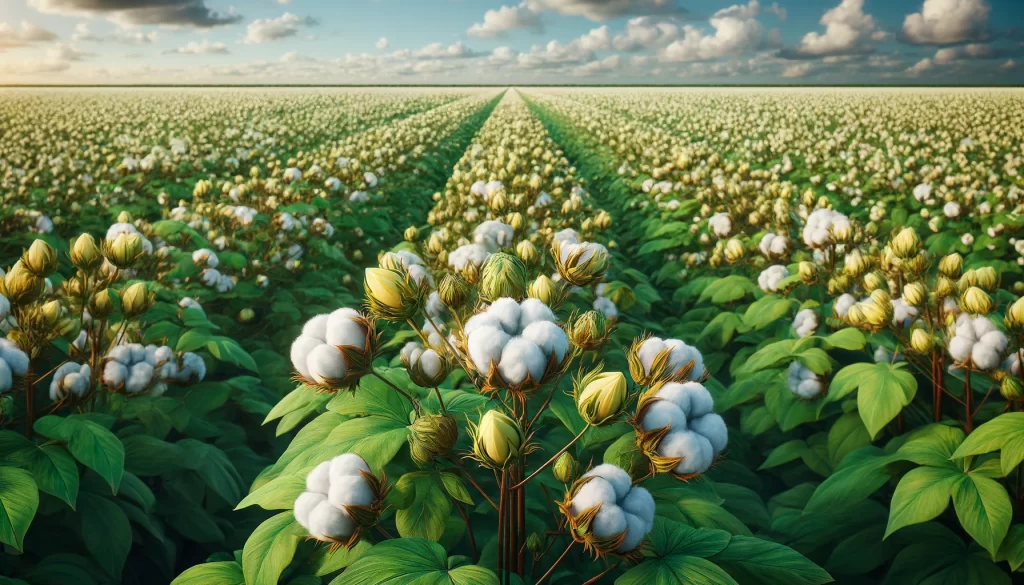
Flowering of cotton is a crucial phase in the life cycle of the plant, as it marks the start of the process of forming the cotton capsules, which contain the prized fibers used in the textile industry. Here is a detailed description of this stage:
- Formation of floral buds: Before flowering, the cotton plant produces floral buds in the axils of the leaves. These buds are crucial for the development of flowers and, subsequently, cotton capsules.
- Start of flowering: Flowering of cotton begins when the floral buds open and develop into complete flowers. Cotton flowers are pale yellow and have a bell-like appearance.
- Pollination: During flowering, pollen is transferred from the stamens of one flower to the pistils of another. Pollination can occur through wind, but in most cases, it is carried out by insects, such as bees and moths.
- Formation of the ovary: After pollination, the ovary of the fertilized flower begins to develop and form the cotton capsule, which will eventually contain the seeds surrounded by cotton fibers.
- Development of the cotton capsule: The cotton capsule continues to grow and develop as flowering progresses. During this process, the cotton fibers elongate and begin to form around the seeds inside the capsule.
- Wilting of the flower: As the cotton capsule continues its development, the flower wilts and falls from the plant, making room for the cotton capsule to mature and expand fully.
Flowering of cotton is a critical stage that largely determines the yield and quality of the final harvest. Proper management during this phase, including promoting effective pollination and protecting against diseases and pests, is essential to ensure optimal development of the cotton capsules and, therefore, a successful harvest of high-quality fibers.
Fruit Setting
After pollination, the fertilized ovules begin to develop and form cotton capsules or bolls. This process marks the start of cotton fiber formation.
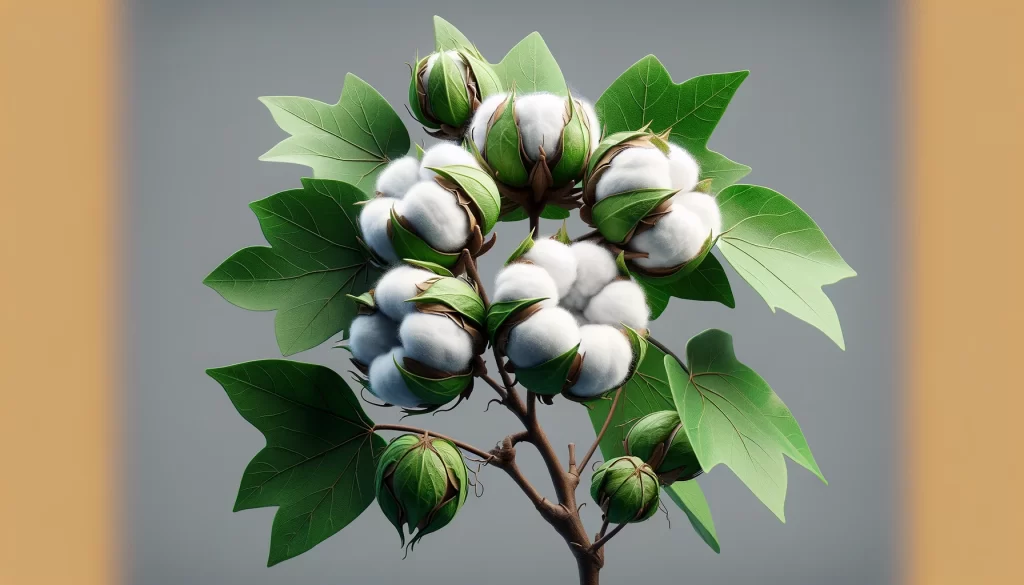
Fruit setting in cotton is a crucial stage in the development of the plant, as it marks the beginning of the formation of the cotton capsules, which contain the seeds surrounded by the prized fibers used in the textile industry. Here is a detailed description of this phase:
- Development of the floral capsule: After pollination, the fertilized flower begins to develop the ovary, which will eventually become the cotton capsule. This initial development of the ovary is essential for proper fruit setting.
- Start of capsule growth: As the fruit setting stage progresses, the cotton capsule begins to grow and expand. During this process, rapid tissue growth occurs, and the basic structure of the capsule is formed.
- Formation of cotton fibers: Simultaneously with the growth of the cotton capsule, cotton fibers begin to develop around the seeds inside. These fibers originate from the epidermal cells of the capsule tissue and elongate to form the characteristic long and thin fibers of cotton.
- Cell division and elongation: During fruit setting, intense cellular activity occurs in the tissues of the cotton capsule. Cells divide and elongate, contributing to the rapid growth of the capsule and the development of cotton fibers.
- Development of seeds: In addition to the development of cotton fibers, the seeds inside the capsule also begin to develop and accumulate nutrient reserves for the growing embryo.
- Protection of the capsule: During this stage, the cotton plant must protect the developing capsules from stress factors such as droughts, diseases, and pests. Proper crop management and timely application of pest and disease control practices can help ensure optimal fruit setting.
Fruit setting is a crucial stage in the life cycle of cotton, as it largely determines the yield and quality of the final harvest. Proper management during this phase is essential to ensure optimal development of the cotton capsules and, therefore, a successful harvest of high-quality fibers.
Fiber Development
During this stage, cotton fibers within the capsules begin to elongate and develop. This process extends over several weeks and is crucial for determining the quality and yield of the fiber.
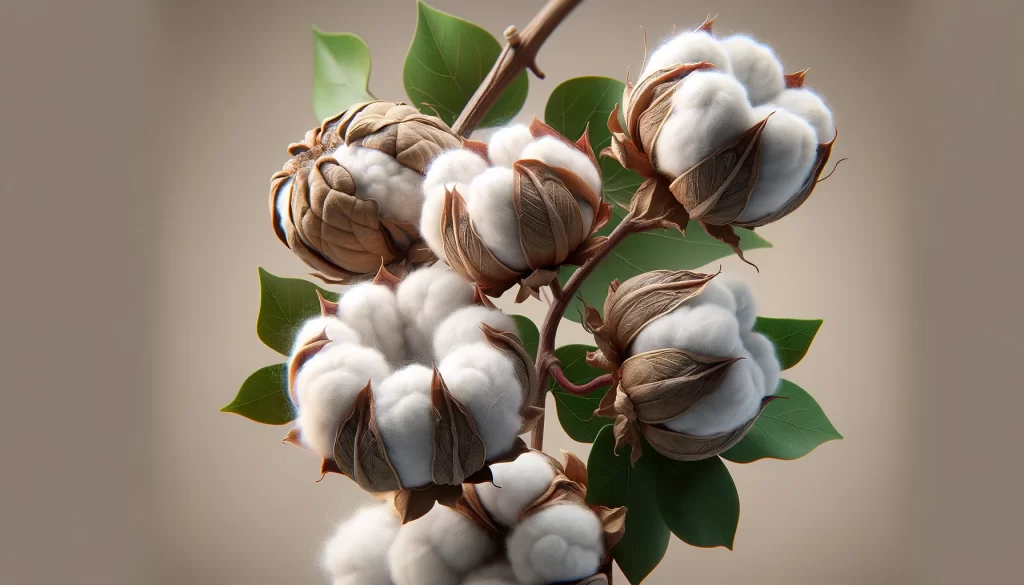
Fiber development in cotton is a fundamental process in the production of this valuable textile plant. Here is a detailed description of this phase:
- Start of fiber development: Fiber development begins within the cotton capsules after pollination and fruit setting. Fibers originate from the epidermal cells of the capsule and begin to elongate and differentiate into specialized cells that will form the cotton fibers.
- Elongation of fibers: During the early stages of fiber development, the fibers begin to elongate rapidly. This elongation process is crucial for the formation of long and thin fibers, characteristic of high-quality cotton.
- Thickening of the cell wall: As the cotton fibers continue to elongate, a process of cell wall thickening also begins. This involves the deposition of cellulose and other compounds within the cell wall of the fiber, increasing its strength and durability.
- Accumulation of cellular content: During fiber development, nutrients and compounds accumulate within the fiber cells. These nutrients provide the energy necessary for growth and the formation of the fiber, as well as for the synthesis of substances that give cotton its characteristic color and texture.
- Formation of the cuticle: As the cotton fibers mature, an outer layer called the cuticle is formed. The cuticle is a waxy layer that coats the surface of the fiber and provides protection against dehydration and mechanical damage.
- Maturation of the fiber: As development progresses, the cotton fibers continue to mature and acquire their final characteristics of length, thickness, color, and strength. This process can take several weeks and is influenced by factors such as the plant’s genetics, climate, and cultivation management practices.
Fiber development is a continuous and dynamic process that culminates in the formation of mature cotton fibers, ready to be harvested and processed into textile products. Proper crop management during this phase is essential to ensure the production of high-quality fibers with the desirable characteristics for the textile industry.
Maturation of the Capsule
As the cotton fibers mature, the capsule that contains them also matures. The capsule dries and opens, exposing the cotton fibers ready to be harvested.
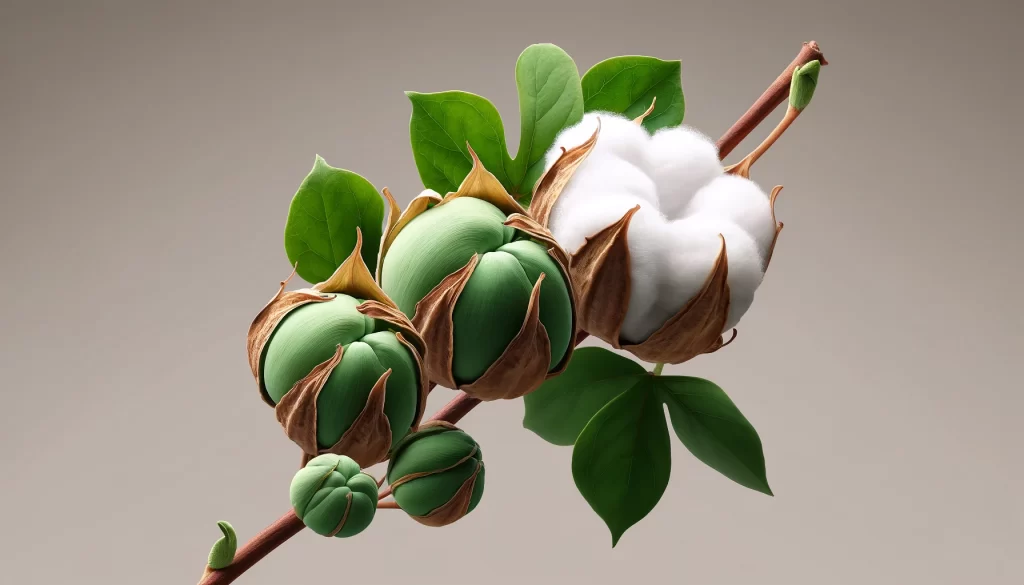
The maturation of the cotton capsule is a crucial stage in the life cycle of the plant, as it marks the final process of seed and cotton fiber development within the capsule. Here is a detailed description of this phase:
- Development of seeds: During capsule maturation, the cotton seeds inside the capsule continue their development. This involves the accumulation of nutrients and the formation of structures such as the embryo and endosperm, which are fundamental for the growth of a new cotton plant from the seed.
- Maturation of cotton fibers: At the same time that the seeds mature, the cotton fibers inside the capsule also undergo their own maturation. This involves the completion of the elongation process and the development of characteristics such as thickness, length, and strength that determine the quality of the cotton fibers.
- Drying of the capsule: As maturation progresses, the cotton capsule begins to dry and lose water. This is important for the preservation of the seeds and fibers within the capsule and for facilitating their subsequent harvest and processing.
- Opening of the capsule: Once the seeds and cotton fibers have reached full maturity, the cotton capsule dries and opens. This allows the seeds and fibers to be released and ready to be harvested.
- Harvest: The complete maturation of the cotton capsule indicates that the seeds and fibers are ready to be harvested. Depending on cultivation management practices and local conditions, the harvest can be carried out manually or using specialized machinery.
- Processing: After the harvest, the cotton capsules are subjected to ginning processes to separate the seeds from the fibers. The seeds can be used for planting in the next cultivation season or for the extraction of cottonseed oil, while the fibers are processed into textile products such as yarns and fabrics.
The maturation of the cotton capsule is a critical stage that determines the optimal timing for harvesting and processing the seeds and cotton fibers. Proper crop management during this phase is essential to ensure the highest quality and yield of the final harvest.
Harvest
Once the cotton capsules are mature and open, the plant is ready to be harvested. The harvest can be carried out manually or using specialized machinery, and the capsules are collected for subsequent processing.

The harvest of cotton is the final process in the production cycle of this valuable textile fiber. Here is a detailed description of this important step:
- Determination of the harvest timing: The harvest of cotton is carried out at a specific time, when the cotton capsules have reached full maturity. This is determined by observing indicators such as the color of the capsules (which usually turns brown), the opening of the capsules, and the ease with which the fibers separate from the seeds.
- Preparation of machinery and equipment: Before starting the harvest, the necessary machinery and equipment, such as cotton harvesters or ginning machines, are prepared. These machines must be in good condition and properly adjusted to ensure an efficient and high-quality harvest.
- Mechanical or manual harvest: The harvest of cotton can be carried out mechanically or manually, depending on agricultural practices and local conditions. In mechanical harvesting, mature capsules are collected by specialized harvesters that separate the capsules from the plant. In manual harvesting, capsules are collected by hand by agricultural workers.
- Transport to the processing location: Once collected, the cotton capsules are transported to the processing location, where ginning will take place to separate the seeds from the fibers. This may involve transport to a nearby ginning plant or to facilities on the same farm.
- Ginning: In the ginning process, the cotton capsules are subjected to specialized machinery that separates the seeds from the fibers. This may involve the use of mechanical ginners that break the capsules and separate the seeds from the fibers, or manual methods such as hand ginning.
- Sorting and storage: Once the seeds and fibers are separated, the fibers are sorted according to their quality and length. High-quality fibers are stored and sent to additional processing facilities, while lower-quality fibers may be used for other purposes. The seeds are also sorted and can be used for planting or for extracting cottonseed oil.
- Processing of the fibers: The stored cotton fibers are subjected to additional cleaning, carding, spinning, and weaving processes to produce cotton yarns and fabrics that will be used in the manufacture of a wide range of textile products.
The harvest of cotton is a crucial process that requires careful planning, appropriate equipment, and skilled labor to ensure a successful and high-quality harvest. Proper management during the harvest is essential to preserve the quality of the fibers and maximize the yield of the crop.
Nutrient Recommendations for Cotton Cultivation
Here is a table showing general nutrient recommendations and their doses for each stage and substage of cotton cultivation:
| Stage/Substage | Nutrients | Recommended Dose |
|---|---|---|
| Soil preparation and planting | Nitrogen (N), Phosphorus (P), Potassium (K) | N: 50-100 kg/ha, P: 50-100 kg/ha, K: 50-100 kg/ha |
| Calcium (Ca), Magnesium (Mg) | Ca: 50-100 kg/ha, Mg: 20-50 kg/ha | |
| Micronutrients (such as iron, manganese, zinc) | According to soil analysis | |
| Vegetative development | Nitrogen (N), Potassium (K) | N: 100-200 kg/ha (split applications), K: 100-200 kg/ha (split applications) |
| Phosphorus (P) | P: 50-100 kg/ha (application at planting) | |
| Calcium (Ca), Magnesium (Mg) | Ca: 50-100 kg/ha, Mg: 20-50 kg/ha | |
| Micronutrients | According to soil or foliar analysis | |
| Flowering and fruit setting | Nitrogen (N), Phosphorus (P), Potassium (K) | N: 100-150 kg/ha, P: 50-100 kg/ha, K: 100-150 kg/ha |
| Calcium (Ca), Boron (B) | Ca: 50-100 kg/ha, B: 1-2 kg/ha | |
| Micronutrients | According to soil or foliar analysis | |
| Formation of seed capsules | Potassium (K), Phosphorus (P) | K: 150-200 kg/ha, P: 50-100 kg/ha |
| Calcium (Ca), Magnesium (Mg) | Ca: 50-100 kg/ha, Mg: 20-50 kg/ha | |
| Micronutrients | According to soil or foliar analysis | |
| Maturation of seed capsules | Potassium (K), Calcium (Ca) | K: 150-200 kg/ha, Ca: 50-100 kg/ha |
| Magnesium (Mg), Phosphorus (P) | Mg: 20-50 kg/ha, P: 50-100 kg/ha | |
| Micronutrients | According to soil or foliar analysis |
These recommendations are general and may vary depending on the specific conditions of the soil, climate, cotton variety, and agricultural practices used. It is recommended to perform soil and foliar analyses periodically to precisely adjust nutrient doses. Additionally, it is essential to follow local regulations and the guidance of agricultural professionals for proper nutrient management in cotton cultivation.
 AgronoBlog – Agriculture Blog
AgronoBlog – Agriculture Blog